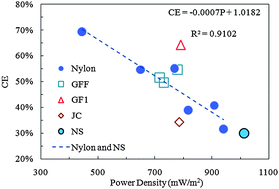The use of nylon and glass fiber filter separators with different pore sizes in air-cathode single-chamber microbial fuelcells
Abstract
Separators are needed in microbial

* Corresponding authors
a
State Key Joint Laboratory of Environment Simulation and Pollution Control, Department of Environmental Science & Engineering, Tsinghua University, Beijing, P.R.China
E-mail:
xhuang@tsinghua.edu.cn
Tel: (+86)10-62772324
b State Key Laboratory of Clean Energy Utilization, Department of Energy Engineering, Zhejiang University, Hangzhou, PR China
c
Department of Civil & Environmental Engineering, Penn State University, 231Q Sackett Building, University Park, PA, USA
E-mail:
blogan@psu.edu
Tel: (+1)814-863-7908
Separators are needed in microbial

 Please wait while we load your content...
Something went wrong. Try again?
Please wait while we load your content...
Something went wrong. Try again?
X. Zhang, S. Cheng, X. Huang and B. E. Logan, Energy Environ. Sci., 2010, 3, 659 DOI: 10.1039/B927151A
To request permission to reproduce material from this article, please go to the Copyright Clearance Center request page.
If you are an author contributing to an RSC publication, you do not need to request permission provided correct acknowledgement is given.
If you are the author of this article, you do not need to request permission to reproduce figures and diagrams provided correct acknowledgement is given. If you want to reproduce the whole article in a third-party publication (excluding your thesis/dissertation for which permission is not required) please go to the Copyright Clearance Center request page.
Read more about how to correctly acknowledge RSC content.
 Fetching data from CrossRef.
Fetching data from CrossRef.
This may take some time to load.
Loading related content
